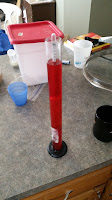
Forgive the title of this post... but Dena Carter...yeah... ok..
So step mashing is a long process. But it definitely improves your beer. The flavor of a step mash, or decoction mash for that case is more... grown up. Not commercial, mind you, just more refined. Yes, I know it isn't necessary. Yes, I know most malts are fully modified now... But a step mash ensures that all phases of the conversion are addressed. And when brewing a Belgian Abbey style it is absolutely necessary if you want to enhance the production of ferulic acid and therefore create more phenolic flavors....
So why am I talking about a step mash in a blog that is clearly focused on Strawberry wine?
Here's why, Step mashing takes so long, that if you are step mashing, you easily have time to make a 1 gallon wine kit, or 1 gallon of fruit wine. And that is exactly what Mark and I did last Saturday. And you should too, if you can make beer, trust me, you can easily make decent wine. In another post Ill talk about wine expectations, and wine snobbery. You can make world class wine at home, but do you really want 30 bottles of some amazing oaky, complex cabernet? Come on, you're a beer guy...or gal... or person... Not a wine snob.
During the mash, Mark and I took 4 lbs. of frozen strawberries, and 1 lb. of frozen mixed berries. Why did we add frozen mixed berries... cause that's what SWMBO brought home. We added all of the berries to a stainless brew pot on the stove and slowly thawed and heated them to 160 F (71 C) for 10 Minutes. It isn't strictly necessary to pasteurize frozen berries, but it doesn't hurt anything, and because you'll be letting the berries hang out in the must for a few days, it is a good idea.
Making wine is easy. And if your SWMBO is like mine, she isn't much of a beer person, wine is a great alternative. Just do your self a favor from your very first batch. Forget all wine snobbery. Make drinkable, easy to make, fast to ferment good wines. I like fruit wines, and the 1 gallon wine expert kits. When I do make a 6 gallon wine kit, it is usually something very easy drinking like, white zinfandel, or one of the Island Mist Kits. They're delicious, and ready in 4 to 5 weeks. Nothing blends better with Saison, than a country wine. An important thing to remember. You will get better and better as you learn more and more. Just like brewing, your first couple of batches will be good, but maybe not great. But trust me, after a couple of batches your understanding will grow and you will be on your way to excellence.
Here's a recipe for an easy Strawberry Wine
Ingredients
 |
| Before sugar Addition |
- 4 – 4.5 pounds strawberries Frozen is fine.
- I usually go 4 pounds of strawberries, and 1 pound of mixed berries, the color is fantastic.
- 1 gallon water
- 2 - 3 pounds corn sugar to a OG of 1.080 minimum.
- I like strawberry wine sweeter so I usually go to 1.100...
- Won't the yeast eat all the sugar?... depends on the yeast. But even if it does, you can back sweeten wine. Easily...
- 1 teaspoon acid blend
- 1/8 teaspoon tannin
- 1/2 teaspoon pectic enzyme
- 1 teaspoon yeast nutrient
- 1 Campden tablet - for when it's time to stop the fermentation.
- 1 package Côte des Blanc or champagne yeast (can substitute regular wine yeast)
- 1 Package of Sparkaloid... or lots of patience... It can take months to clear.
- I generally just wait. 1 gallon is 5-6 bottles of wine. If you make 1 or two a month you'll be swimming in wine.
- Wash and remove the stems and leaves.
- if using frozen this is done for you already. I just slowly bring the fruit and1 gallon of water to 160 for 10 minutes. And I mash it up with a potato masher.
- Use a straining bag and fill with the crushed strawberries. Tie the top, and leave straining bag in a sterilized bucket.
- Add water if needed, sugar, and acid blend, tannin, pectic enzyme, and yeast nutrient. Stir well.
- Before you add the yeast, you will need to sterilize the must. Crush up one Campden tablet and add to the must. Stir and cover for 24 hours. Now you may add the yeast. Stir well, cover, and stir every day for 4-5 days.
- Then siphon into your 1 gallon jug, put the rubber stopper on and airlock.
- It will take about 2-3 months before your wine is clear enough to bottle.
- You can make more than just 1 gallon if you just multiply out the recipe.
- I used half a pack of yeast for this batch.
Can I use other fruits? Of course, just about any fruit can become wine. Even garlic... yup... it's gross. But Apples, Pears, Grapes, Apricots, Strawberries, Raspberries, Blackberries are all easily done.
How do I learn to make other fruit wines? Well first you understand that winemaking is a process. Kind of like brewing is a process. But in wine making the quality of the ingredients are very important. It took me a long time to realize that the strawberries from Wal-Mart were actually better for wine making than the strawberries from WholePaycheck market.
Where can I learn more? Not surprisingly, Beer and Wine Journal is an excellent resource. As well as this article written by Beer and Wind journal editor Chris Colby for Grit Magazine.
That's all for now sports fans.
Prost!












































